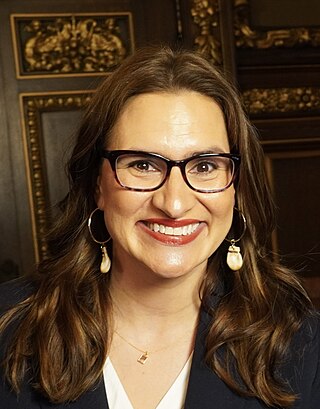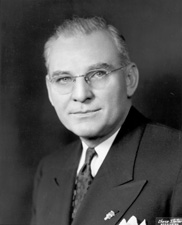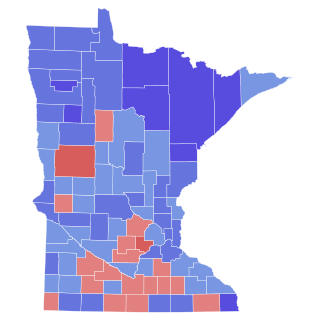| |||||||||||||||||
| |||||||||||||||||
| |||||||||||||||||
| Elections in Minnesota |
|---|
 |
The 1944 Minnesota lieutenant gubernatorial election took place on November 7, 1944. Republican Party of Minnesota candidate C. Elmer Anderson defeated Minnesota Democratic-Farmer-Labor Party challenger Frank Murphy.
| |||||||||||||||||
| |||||||||||||||||
| |||||||||||||||||
| Elections in Minnesota |
|---|
 |
The 1944 Minnesota lieutenant gubernatorial election took place on November 7, 1944. Republican Party of Minnesota candidate C. Elmer Anderson defeated Minnesota Democratic-Farmer-Labor Party challenger Frank Murphy.
| Party | Candidate | Votes | % | ±% | |
|---|---|---|---|---|---|
| Republican | C. Elmer Anderson | 641,558 | 58.12% | +2.47% | |
| Democratic (DFL) | Frank Murphy | 462,222 | 41.88% | -2.47% | |
| Majority | 179,336 | 16.24% | |||
| Turnout | 1,103,780 | ||||
| Republican hold | Swing | ||||

The Minnesota Democratic–Farmer–Labor Party (DFL) is the affiliate of the Democratic Party in the U.S. state of Minnesota. As of 2024, it controls four of Minnesota's eight U.S. House seats, both of its U.S. Senate seats, the Minnesota House of Representatives and Senate, and all other statewide offices, including the governorship, making it the dominant party in the state.

The Republican Party of Minnesota is the state affiliate of the Republican Party in Minnesota and the oldest active political party in the state. Founded in 1855, the party controls four of Minnesota's eight congressional House seats. The last Republican governor of the state was Tim Pawlenty, who served from 2003 to 2011. The party's headquarters is located in Edina, Minnesota and the current chairman is David Hann. Starting in 2023 and as a result of the 2022 elections, the Republican Party of Minnesota does not have substantial power over the state, holding no statewide executive offices, no U.S. Senate seats, and minorities in the state legislatures.

The lieutenant governor of Minnesota is a constitutional officer in the executive branch of the U.S. state of Minnesota. Fifty individuals have held the office of lieutenant governor since statehood. The incumbent is Peggy Flanagan, a DFLer and the first Native American elected to a statewide executive office in Minnesota's history.
The Minnesota Democratic Party was a political party in Minnesota that existed from the formation of Minnesota Territory in 1849 until 1944, when the party merged with the Minnesota Farmer-Labor Party to form the modern Minnesota Democratic-Farmer-Labor Party.

The attorney general of Minnesota is a constitutional officer in the executive branch of the U.S. state of Minnesota. Thirty individuals have held the office of Attorney General since statehood. The incumbent is Keith Ellison, a DFLer.

The secretary of state of Minnesota is a constitutional officer in the executive branch of government of the U.S. state of Minnesota. Twenty-two individuals have held the office of secretary of state since statehood. The incumbent is Steve Simon, a DFLer.

The state treasurer of Minnesota was a constitutional officer in the executive branch of the U.S. state of Minnesota. Twenty-six individuals occupied the office of state treasurer from 1858 until the office's abolition in 2003. The final state treasurer was Carol C. Johnson, a DFLer.

Minnesota is known for a politically active citizenry, with populism being a longstanding force among the state's political parties. Minnesota has consistently high voter turnout; in the 2008 U.S. presidential election, 77.8% of eligible Minnesotans voted – the highest percentage of any U.S. state or territory – versus the national average of 61.7%. This was due in part to its same day voter registration laws; previously unregistered voters can register on election day, at their polls, with evidence of residency.

The 1944 Minnesota gubernatorial election took place on November 7, 1944. Republican Party of Minnesota candidate Edward John Thye defeated Minnesota Democratic–Farmer–Labor Party challenger Byron G. Allen. As the Democratic Party of Minnesota and Farmer–Labor Party merged earlier in the year, this was the first gubernatorial election in which the parties ran a combined ticket. The vote change below reflects the departure from the combined Democratic and Farmer–Labor totals in 1942.

The 1942 Minnesota gubernatorial election took place on November 3, 1942. Republican Party of Minnesota candidate Harold Stassen defeated Farmer–Labor Party challenger Hjalmar Petersen. This was the last election in which the Democratic Party of Minnesota and the Farmer–Labor Party ran separate candidates; in 1944, both parties ran under the umbrella of the Minnesota Democratic–Farmer–Labor Party. Martin A. Nelson and John G. Alexander unsuccessfully ran for the Republican nomination.

The 1980 United States presidential election in Minnesota took place on November 4, 1980 as part of the 1980 United States presidential election. State voters chose ten representatives, or electors to the Electoral College, who voted for President and Vice-President.

The 1948 United States Senate election in Minnesota took place on November 2, 1948. It was the first election held for Minnesota's Class 2 seat in the United States Senate since the Minnesota Democratic Party and the Farmer-Labor Party of Minnesota merged in 1944 to form the Minnesota Democratic-Farmer-Labor Party. Democratic Mayor of Minneapolis and future Vice President Hubert H. Humphrey defeated incumbent Republican Joseph H. Ball, who sought a third term in the Senate. This is the first time a Democrat won a Senate seat in Minnesota through popular vote election.

The 1946 United States Senate election in Minnesota took place on November 5, 1946. It was the first election to either of Minnesota's seats in the United States Senate held since the Minnesota Democratic Party and the Farmer-Labor Party of Minnesota merged in 1944, to form the Minnesota Democratic-Farmer-Labor Party. Incumbent U.S. Senator Henrik Shipstead was defeated in the Republican primary by Governor Edward John Thye, who went on to defeat DFL challenger Theodore Jorgenson in the general election.

The 1932 United States presidential election in Minnesota took place on November 8, 1932 as part of the 1932 United States presidential election. Voters chose 11 electors, or representatives to the Electoral College, who voted for president and vice president.